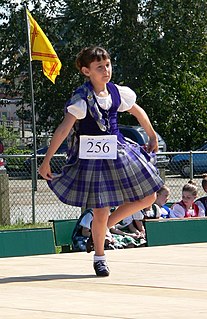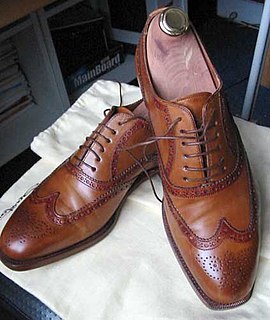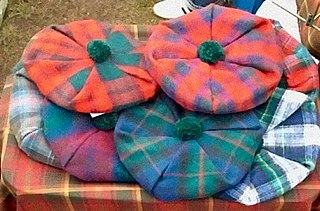 W
WAn earasaid, or arasaid is a draped garment worn in Scotland as part of traditional female highland dress. It may be a belted plaid, or an unbelted wrap. Traditionally, earasaids might be plain, striped or tartan; they might be brightly coloured or made of lachdan wool. Some colours were more expensive than others. Modern highland dress makes earasaids from the same heraldic tartan cloth used for kilts.
 W
WHighland dress is the traditional, regional dress of the Highlands and Isles of Scotland. It is often characterised by tartan. Specific designs of shirt, jacket, bodice and headwear may also be worn along with clan badges and other devices indicating family and heritage.
 W
WThe aboyne dress is the name given to the prescribed attire for female dancers in the Scottish national dances, such as the Flora MacDonald's fancy, the Scottish lilt, and others. Male dancers wear the kilt for these dances, the kilt being a male garment. There are two versions of the aboyne dress in use. Some consider the aboyne as quite suited to the graceful movements of the National dances.
 W
WAn argyle pattern is made of diamonds or lozenges. The word is sometimes used to refer to an individual diamond in the design, but more commonly refers to the overall pattern. Most argyle contains layers of overlapping motifs, adding a sense of three-dimensionality, movement, and texture. Typically, there is an overlay of intercrossing diagonal lines on solid diamonds.
 W
WThe Argyll Highland jacket is a shorter than regular jacket with gauntlet cuffs and pocket flaps and front cutaway for wearing with a sporran and kilt. It can be of tweed, tartan or solid colour material. The Argyll is the standard day wear jacket.
 W
WThe Balmoral is a traditional Scottish hat that can be worn as part of formal or informal Highland dress. Developed from the earlier blue bonnet, dating to at least the 16th century, it takes the form of a knitted, soft wool cap with a flat crown. It is named after Balmoral Castle, a royal residence in Scotland. It is an alternative to the similar and related (informal) Tam o' Shanter cap and the Glengarry bonnet.
 W
WThe belted plaid is a large blanket-like piece of fabric which is wrapped around the body with the material pleated or, more accurately, loosely gathered and secured at the waist by means of a belt. Typically, a portion of the belted plaid hangs down to about the knees or ankles with the rest of the material being wrapped up around the upper body in a variety of ways and pinned or otherwise secured to keep it in place.
 W
WThe blue bonnet was a type of soft woollen hat that for several hundred years was the customary working wear of Scottish labourers and farmers. Although a particularly broad and flat form was associated with the Scottish Lowlands, where it was sometimes called the "scone cap", the bonnet was also worn in parts of Northern England and became widely adopted in the Highlands.
 W
WThe brogue is a style of low-heeled shoe or boot traditionally characterised by multiple-piece, sturdy leather uppers with decorative perforations and serration along the pieces' visible edges.
 W
WA clootie is a strip or piece of cloth, a rag or item of clothing; it can also refer to fabric used in the patching of clothes or the making of clootie mats.
 W
WDoublet is the term describing any of several types of jacket worn with Scottish highland dress; referring to both uniform and evening jackets.
 W
WThe feather bonnet is a type of military headdress used mainly by the Scottish Highland infantry regiments of the British Army from about 1763 until the outbreak of World War I. It is now mostly worn by pipers and drummers in various bands throughout the world. It is also worn in a similar fashion by regiments in various Commonwealth armies.
 W
WThe modern fly plaid originated with the traditional Féileadh Mòr worn in the Scottish Highlands. The Great Plaid was a large piece of cloth, which by the 16th century measured up to 8.2 metres in length, half of which was pleated and belted about the waist, while the upper half was draped over the left shoulder, was then gathered in front and could be used as a cloak and hood during inclement weather.
 W
WA full plaid, or just a plaid, is a long piece of tartan or checked fabric, most often worn as part of a highland dress. It usually matches the tartan of the kilt. A full plaid is pleated the whole way, with half of its length sewn shut. Its length is almost twice the height of the wearer.
 W
WA Ghillie shirt, also known as Jacobean or Jacobite, is an informal traditional shirt usually worn with a kilt. The term Ghillie refers to the criss-crossed lacing style made of leather as also seen on the Ghillie Brogue. Ghillie shirts are considered to be more casual than their shirt and waist-coat counterpart that is normally seen with the kilt. The Ghillie shirt existed before the kilt, with there being no documentation for kilts until 1575.
 W
WA ghillie suit is a type of camouflage clothing designed to resemble the background environment such as foliage, snow or sand. Typically, it is a net or cloth garment covered in loose strips of burlap (hessian), cloth, or twine, sometimes made to look like leaves and twigs, and optionally augmented with scraps of foliage from the area.
 W
WGlen plaid, also known as Glenurquhart check or Prince of Wales check, is a woollen fabric with a woven twill design of small and large checks. It is usually made of black/grey and white, or with more muted colours, particularly with two dark and two light stripes alternate with four dark and four light stripes which creates a crossing pattern of irregular checks. Glen plaid as a woven pattern may be extended to cotton shirting and other non-woollen fabrics.
 W
WThe Glengarry bonnet is a traditional Scots cap made of thick-milled woollen material, decorated with a toorie on top, frequently a rosette cockade on the left side, and ribbons hanging behind. It is normally worn as part of Scottish military or civilian Highland dress, either formal or informal, as an alternative to the Balmoral bonnet or Tam o' Shanter.
 W
WThe history of the kilt stretches back to at least the end of the 16th century. The kilt first appeared as the belted plaid or great kilt, a full-length garment whose upper half could be worn as a cloak draped over the shoulder, or brought up over the head as a hood. The small kilt or walking kilt did not develop until the late 17th or early 18th century, and is essentially the bottom half of the great kilt.
 W
WHodden or wadmel is a coarse kind of cloth made of undyed wool, formerly much worn by the peasantry of Scotland. It was usually made on small hand-looms by the peasants. Hodden grey was made by mixing black and white fleeces together in the proportion of one to twelve when weaving. The origin of the word is unknown.
 W
WThe Inverness cape is a form of weatherproof outer-coat. It is notable for being sleeveless, the arms emerging from armholes beneath a cape. It has become associated with the fictional detective Sherlock Holmes.
 W
WThe Inverness cape is a form of weatherproof outer-coat. It is notable for being sleeveless, the arms emerging from armholes beneath a cape. It has become associated with the fictional detective Sherlock Holmes.
 W
WA kilt is a type of knee-length men’s dress skirt non-bifurcated with pleats at the back, originating in the traditional dress of Gaelic men and boys in the Scottish Highlands. It is first recorded in the 16th century as the great kilt, a full-length garment whose upper half could be worn as a cloak. The small kilt or modern kilt emerged in the 18th century, and is essentially the bottom half of the great kilt. Since the 19th century, it has become associated with the wider culture of Scotland, and more broadly with Gaelic or Celtic heritage. It is most often made of woollen cloth in a tartan pattern.
 W
WThe modern, tailored kilt which is ubiquitous at Highland games gatherings around the world has associated with it an evolving style of wear. This style includes the accessories and other accoutrements which are typically worn with it. In this sense, it is very much like other items of the fashion world.
 W
WThe kilt pin is a piece of jewellery that is usually worn on the lower corner of the outer apron of a kilt. Its function is to prevent the apron falling or blowing open, by adding weight to the outer apron and is commonly seen as a form of decoration. It does not pin the outer apron to the inner fabric, which is a common misconception.
 W
WA Luckenbooth brooch is a Scottish heart-shaped brooch. These brooches often have a crown above one heart, or two intertwined hearts. They are typically made of silver and may be engraved or set with stones.
 W
WA maud is a woollen blanket or plaid woven in a pattern of small black and white checks known as Border tartan, Falkirk tartan, Shepherd's check, Shepherd's plaid or Galashiels grey. It was in common use as an item of clothing in the southern counties of Scotland and the northern counties of England until the early twentieth century.
 W
WPaisley or paisley pattern is an ornamental textile design using the boteh or buta, a teardrop-shaped motif with a curved upper end. Of Persian origin, paisley designs became popular in the West in the 18th and 19th centuries, following imports of post–Mughal Empire versions of the design from India, especially in the form of Kashmir shawls, and were then replicated locally.
 W
WPaisley shawls were a fashionable item of women's clothing in the 19th century made of intricately woven and delicate wool. Although known as the Paisley pattern, the teardrop motif originated in Persia and India, becoming popular in Europe—and synonymous with Paisley, Renfrewshire—in the 19th century.
 W
WThe sgian-dubh is a small, single-edged knife worn as part of traditional Scottish Highland dress along with the kilt. Originally used for eating and preparing fruit, meat, and cutting bread and cheese, as well as serving for other more general day-to-day uses such as cutting material and protection, it is now worn as part of traditional Scottish dress tucked into the top of the kilt hose with only the upper portion of the hilt visible. The sgian-dubh is normally worn on the same side as the dominant hand.
 W
WThe sporran, a traditional part of male Scottish Highland dress, is a pouch that performs the same function as pockets on the pocketless kilt. Made of leather or fur, the ornamentation of the sporran is chosen to complement the formality of dress worn with it. The sporran is worn on a leather strap or chain, conventionally positioned in front of the groin of the wearer.
 W
WIn the 1820s, two English brothers, John Carter Allen (1795–1872) and Charles Manning Allen (1802–1880) adopted the names John Sobieski Stuart and Charles Edward Stuart, moved to Scotland, became Roman Catholics, and about 1839 began to claim that their father, Thomas Allen (1767–1852), a former Lieutenant in the Royal Navy, had been born in Italy the only legitimate child of Prince Charles Edward Stuart and his wife Princess Louise of Stolberg-Gedern. They claimed that Thomas had, for fear of kidnapping or assassination, been brought secretly to England on a ship captained by their grandfather, Admiral John Carter Allen (1725-1800), and adopted by him. Thomas was thus, they claimed, ‘de jure monarch of England in place of the then reigning sovereign Queen Victoria’.
 W
WA tam o' shanter, or 'tammie' is a name given to the traditional Scottish bonnet worn by men. The name derives from Tam o' Shanter, the eponymous hero of the 1790 Robert Burns poem.
 W
WTrews are men's clothing for the legs and lower abdomen, a traditional form of tartan trousers from Scottish Highland dress. Trews could be trimmed with leather, usually buckskin, especially on the inner leg to prevent wear from riding on horseback.
 W
WTweed is a rough, woollen fabric, of a soft, open, flexible texture, resembling cheviot or homespun, but more closely woven. It is usually woven with a plain weave, twill or herringbone structure. Colour effects in the yarn may be obtained by mixing dyed wool before it is spun.
 W
WWadmal is a coarse, dense, usually undyed wool fabric woven in Iceland, Norway, Sweden, Denmark, Greenland, and the Orkney, Faroe and Shetland Islands from the Middle Ages into the 18th century. Wadmal was woven on the warp-weighted loom used throughout these areas of Norwegian influence, and was usually a 2/2 twill weave, although some medieval sources outside Iceland describe wadmal as tabby or plain-woven. In remote regions, wadmal remained the primary fabric for working people's clothing into the 18th century.
 W
WThe wardrobe of Mary, Queen of Scots, was described in several contemporary documents, and many records of her costume have been published.